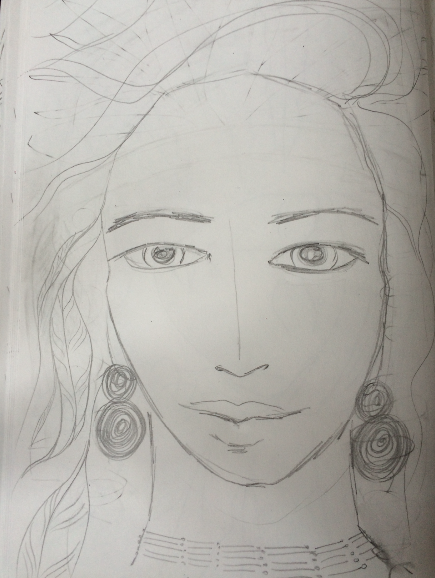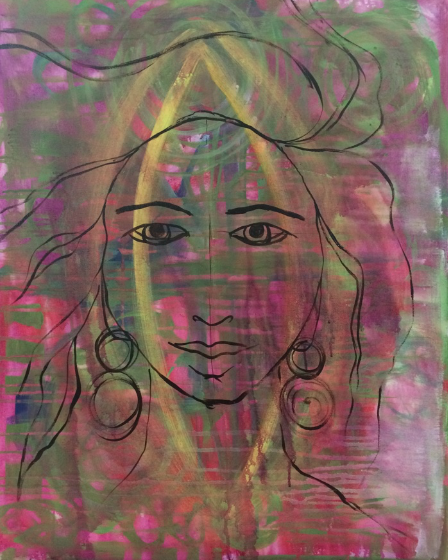Week Two ~ Intuition & Creativity
The heart of creativity is an experience of the mystical union; the heart of the mystical union is an experience of creativity. - Julia Cameron
TRUSTING OUR INFINITELY CREATIVE INTUITION
Today your painting looks one way, and tomorrow it changes...
I can't tell you how many of my paintings have what seem to be several complete paintings underneath their final layers. During the years where my dining room also played the role of art studio, my family would joke, question and sometimes lament the dramatic turns my paintings would take in their process of coming to life.
And to be completely honest, so did I on more than one occasion. The practice of non-attachment is real in an intuitive, spirit-led approach to creative expression.
Sometimes the practice is to trust when you are feeling an inner nudge to let something go that you have fallen in love with, and sometimes our intuition leads us beyond our initially uncomfortable layers towards something that I can only attempt to understand as a more healed expression of the layers beneath.
Either way, our work is to neither attach ourselves to the parts we love, nor the parts that create discomfort, but to let our intuition to lead the way towards our next temporary destination.
What is your image asking for next?
Getting to know our materials
Using high quality materials can sometimes be the difference between feeling uninspired and WOWed by your creative journey. That said, if your options are to go with cheaper options or not making art, go to the dollar store and hook yourself up! If you are thinking of setting yourself up with a home studio kit, here are some of the supplies that we use in class...
Easels - Optional. I often paint on the floor either kneeling or sitting on a cushion. Sometimes I've even covered a chair with a dropcloth as a makeshift easle and sat in a chair across from it. Otherwise, aluminium, lightweight, easy to store easels are a great lower cost option. There are also lovely wood ones if you have a more permanent space you can set up.
Painting surface - In terms of painting on canvas, I prefer to use heavy texture, pre-stretched/pre-primed canvas. At Michaels, these are the highest quality (green label) canvases they carry. Other fun painting surfaces include watercolour paper, wood, reclaimed second-hand store art (a coat of primer and you are set!) Another favourite and super low cost option is to go to the hardware store and pick up a 4x8' sheet of wall panel. This runs about $12 a sheet. Several hardware stores with also cut the sheet down for you so you have several panels to play on. I've cut a panel down to 12 smaller pieces, which means each one is only $1!!! This is a great way to take the pressure off if you are hung up on painting on an expensive canvas. These panels can be framed and hung just as beautifully. Always prime these before you dive in.
Paint - In terms of brands, I prefer Golden Fluid Acrylics, Golden Heavy Body Acrylics, or Liquitex Heavy Body Acrylics. Keep in mind the fluid paints are great for semi-transparent layering, drippy bits, and liner work. Heavy bodies are awesome for thick vibrant accents later on in your painting, creating texture, or for the greatest coverage.
Brushes - Its fun to experiment with brushes in your paint practice. Different shapes give you a variety of thicknesses and feelings to your painting. Try square, round, long, short, fluffy, and stiff brushes. Hog hair brushes are great for drybrushing techniques, and they are cheap so they are low-risk when you are scrubbing them hard on the canvas. Synthetic brushes in a variety of sizes are useful for outlining, drawing, and details. Both hog hair and synthetic brush sets can be found locally at Michael's or the painted turtle.
Palette - There are lots of different palette options. My favourite is to have a piece of glass, or small old window to use as a palette. Both can be found at the restore or probably in your shed. A large piece of glass could cover your entire painting table, or a small window could be held or placed nearby. I prefer this type of palette as I never have to wash the paint down the drain. At the end of a painting session I just let any smeared paint leftover dry on the glass. The next time I go to paint I spray the glass with my spray bottle, let sit 1 min, and scrape paint off with a window scraper and toss into the garbage. Its the most eco-friendly solution I've found thus far. Other options include, plates, baby wipe container (travel variety), art palette (wood or plastic).
Other Tools - Spray bottle for dripping and/or thinning paint, rag, charcoal for sketching on canvas (optional), apron, floor protection, foamy brushes, found objects that make interesting marks (lids in all sizes, bubble wrap, pinecones, sponges, old pencils or pokey things to make dots, stencils, straws,etc.)
** I try to by as much as possible locally, but some things are way more expensive here or simple aren't available so I've had to look elsewhere. A few online options that I have used are Dickblick art supplies, utrecht art supplies, and Opus Art Supplies.
Click HERE to link to an online supply list with all my favourite paint colours at Blick.com (all the paint quantities are 4 oz. on this but you could certainly get several paintings from 1oz. bottles if you want to switch it)
Steps 3-5 Reviewed
Step 3 ~ Calling in Your Vision
Go into meditation and imagine a being/image begin to appear
Notice all details, energy, feelings that this image brings
Commune with the Muse that appears
Rough sketch, write, jot down all details you can remember
Sketch again, refining and keeping composition in mind
Step 4 ~ Bringing Vision into Form
Paint outline on canvas
Use a small, synthetic round brush
Use 1 colour that contrasts with background
Looks like a colouring book image ready for colouring
Step 5 ~ Laying the Foundation
Choose 3 colours to begin colouring in image
Dry-brush technique with hog hair brushes proportional to the area being painted (choose larger rather than smaller brushes)
Use little paint on brush/circular motion
Vary coverage, allowing background to show through in some places
Leave 'glow' around lines randomly leaving space between the area being filled and the outline






